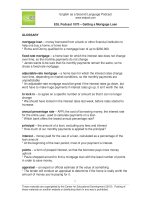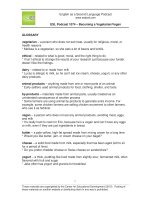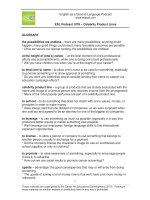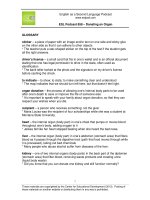ESL podcast 897 cooking a meal
Bạn đang xem bản rút gọn của tài liệu. Xem và tải ngay bản đầy đủ của tài liệu tại đây (89.59 KB, 9 trang )
English as a Second Language Podcast
www.eslpod.com
ESL Podcast 897 – Cooking a Meal
GLOSSARY
pan – a metal object with a round bottom, short sides, and one long handle, used
to cook food on a stove
* Do you have a smaller pan that I can use to scramble some eggs?
pot – a metal object with a round bottom, tall sides, and one or two handles,
used to cook food on a stove
* Is this pot big enough to boil all those noodles?
to pan-fry – to cook something in a small amount of oil in a pan over high heat
on a stove
* I prefer to pan-fry this fish rather than bake it in the oven.
to steam – to cook something, especially vegetables, in water vapor so that they
do not touch liquid water directly
* Broccoli and carrots retain more nutrients if you steam the, instead of cooking
them directly in boiling water.
to grill – to cook something on a metal frame over an open fire; to barbeque
* They grill a lot of fish in their backyard during the summer.
to heat – to warm something up; to increase the temperature of something,
especially when cooking
* Please heat the spaghetti sauce, but don’t let it boil.
saucepan – a small pot with tall sides, used for making thick liquids that are
poured over mixtures of vegetables, meats, and/or foods
* Trent added butter, garlic, flour, milk, and cheese to a saucepan and stirred.
to microwave – to cook something in a microwave (an appliance that heats
foods very quickly)
* We don’t have time to cook a nice meal tonight. Let’s just microwave the
leftovers from last night’s dinner.
to simmer – to gently boil, with small bubbles coming to the surface of a liquid
* The longer you let the chili simmer, the better the flavor.
consistency – the texture of a food, especially how thick, thin, lumpy, or smooth
it is
* The consistency of the gravy was awful. There were little lumps of flour in it.
1
These materials are copyrighted by the Center for Educational Development (2013). Posting of
these materials on another website or distributing them in any way is prohibited.
English as a Second Language Podcast
www.eslpod.com
ESL Podcast 897 – Cooking a Meal
to slice – to cut something into thin, wide pieces
* Please slice some cheese to put on the sandwiches.
to marinade – to place a meat or vegetable in a flavorful liquid for a period of
time to make it softer and/or better-tasting before cooking it
* Ward marinated the tuna in a mixture of orange juice, lemon juice, olive oil, and
soy sauce.
to broil – to cook the outer edge of something by placing it in direct contact with
a heat source or very close to it
* To make garlic bread, spread Italian bread with a mixture of butter and garlic,
and then broil it for a few minutes until it is a golden brown.
to bake – to cook something by surrounding it with hot air, usually in an oven
* The recipe says to bake the muffins for 25 minutes at 400 degrees.
dried out – with most or all of the liquid having been evaporated, so that a food it
tough or crunchy, not moist and chewy
* The cheese will get dried out if you don’t put it in a bag or container.
cutting board – a flat, rectangular piece of wood or plastic, used to protect the
counter or table while one is cutting foods with a sharp knife
* Please get out the cutting board and cut up some carrot sticks.
to chop – to cut a fruit or vegetable into pieces, usually about ¼-inch on each
side, but without trying to make all the pieces the same size or shape
* Chopping onions always makes me cry.
to dice – to cut a fruit or vegetable into small pieces, usually less than ¼-inch on
each side, but without trying to make all the pieces the same size or shape
* To make salsa, you’ll need to dice a lot of tomatoes.
2
These materials are copyrighted by the Center for Educational Development (2013). Posting of
these materials on another website or distributing them in any way is prohibited.
English as a Second Language Podcast
www.eslpod.com
ESL Podcast 897 – Cooking a Meal
COMPREHENSION QUESTIONS
1.
a)
b)
c)
Which type of food preparation requires oil?
Pan-frying.
Steaming.
Microwaving.
2.
a)
b)
c)
What does Emeril want Rachel to do after she slices the meat?
Soak it in a flavored liquid.
Hit it with a wooden hammer to make it more tender.
Cook it on the stovetop.
______________
WHAT ELSE DOES IT MEAN?
pan
The word “pan,” in this podcast, means a metal object with a round bottom, short
sides, and one long handle, used to cook food on a stove: “Please sauté the
onions and garlic in a pan.” The phrase “a flash in the pan” describes something
that becomes successful or popular very quickly, but that does not last for long
and that probably will not be successful or popular again: “The band had a really
popular song, but it was a flash in the pan and none of their other songs ever
became well known.” Finally, the phrase “to pan out” means for something to
become successful or to lead to something good: “Joanna will be interviewing for
a job at two different companies and hopes that at least one will pan out.”
to chop
In this podcast, the verb “to chop” means to cut a fruit or vegetable into pieces,
usually about ¼-inch on each side, but without trying to make all the pieces the
same size or shape: “Please chop the bell peppers into bite-sized pieces.” The
verb “to chop” can also mean to cut wood into smaller pieces for a fire: “How
much firewood did pioneers have to chop each year?” The verb “to chop” can
also mean to significantly reduce the size or amount of something, especially
when talking about money: “Other stores will be forced to chop their prices if they
want to compete with us.” Finally, the phrase “to chop (something) down” means
to cut a tree and make it fall down: “Who chopped down the cherry tree?”
3
These materials are copyrighted by the Center for Educational Development (2013). Posting of
these materials on another website or distributing them in any way is prohibited.
English as a Second Language Podcast
www.eslpod.com
ESL Podcast 897 – Cooking a Meal
CULTURE NOTE
Easy-to-Make Meals
In the United States, there are many popular “easy-to-make” (not requiring very
much time or effort) meals. Many of the meals are also especially popular in
families with young children who are often “picky eaters” (people who dislike
many foods).
“Mac and cheese” or “macaroni and cheese” is a “comfort food” (a food that
many people eat as children and that make them feel safe or happy) that is easy
to prepare. A thick cheese sauce is mixed with small noodles, and sometimes
people add vegetables like peas or some diced ham or canned tuna fish. The
sauce is easy to make, but many people “prefer” (like more) to buy a prepared
version sold in a box with a cheese “packet” (small envelope), which contains a
packet that is simply mixed with butter and milk.
Grilled cheese is another easy-to-make meal. Slices of cheese are placed
between two slices of “buttered” (with butter spread on the surface) bread, and
then the sandwich is grilled in a pan until it is a golden brown. Sometimes people
add slices of ham, turkey, or tomato. Grilled cheese sandwiches are often served
with canned tomato soup.
Another easy-to-make meal is “franks & beans.” The cook slices “frankfurters”
(hot dogs) and cooks them with canned baked beans (beans that have been
cooked in a sweet and salty sauce).
Some families eat a lot of “casseroles” (one-dish meals made by mixing many
ingredients and baking them in the oven). Casseroles can be made from almost
any combination of “leftovers” (food that was not eaten in one meal, but is saved
for later). The easiest versions mix chopped meats and vegetables with a can of
cream of mushroom soup and/or beaten eggs, with cheese “sprinkled” (placed
lightly) over the top.
______________
Comprehension Questions Correct Answers: 1 – a; 2 – a
4
These materials are copyrighted by the Center for Educational Development (2013). Posting of
these materials on another website or distributing them in any way is prohibited.
English as a Second Language Podcast
www.eslpod.com
ESL Podcast 897 – Cooking a Meal
COMPLETE TRANSCRIPT
Welcome to English as a Second Language Podcast number 897: Cooking a
Meal.
This is English as a Second Language Podcast episode 897. I'm your host, Dr.
Jeff McQuillan, coming to you from the Center for Educational Development in
beautiful Los Angeles, California.
Our website is ESLPod.com. Go there. Become a member. Support this podcast.
This episode is a dialog between Rachel and Emeril about cooking something to
eat. Let’s get started.
[start of dialog]
Emeril: Can you hand me that pan?
Rachel: This pot?
Emeril: No, that pan over there. I need to pan-fry these vegetables.
Rachel: Wouldn’t be healthier if we steamed the vegetables or grilled them?
Emeril: Maybe, but for this meal, I’m frying them in this pan.
Rachel: Okay, do you want me to heat this sauce in this saucepan?
Emeril: No, I’m going to microwave that right before I serve it.
Rachel: Have you considered simmering it in a saucepan to get a better
consistency?
Emeril: We don’t have time for that. Slice this meat and marinade it before I broil
it.
Rachel: Maybe we could bake it at a lower temperature so that the meat won’t
get dried out.
Emeril: We’ll try that another time. Can you get that cutting board and chop these
carrots and dice these onions?
5
These materials are copyrighted by the Center for Educational Development (2013). Posting of
these materials on another website or distributing them in any way is prohibited.
English as a Second Language Podcast
www.eslpod.com
ESL Podcast 897 – Cooking a Meal
Rachel: Sure, but don’t you think...?
Emeril: What I think is that there will be six hungry children coming through that
door in an hour and I need to finish dinner. You’re here to help, right?
Rachel: Yes, of course. That’s exactly what I was trying to do.
[end of dialog]
Emeril begins by saying to Rachel, “Can you hand me that pan?” “To hand
(hand)” someone something means to give it to them with your hand. A “pan”
(pan) is a metal object with a round bottom that we use to cook food on what we
call a “stove.” A “stove” (stove) is where you have a small fire or heat that comes
from below, and you put something on top of that heat in order to cook it. Usually,
on a stove, we use what's called a pan.
Rachel is a little confused. She says, “This pot?” A “pot” (pot) is a kind of pan, but
it's got very long sides so that it holds a lot of liquid, a lot of water. If you're going
to make soup, you would use a pot. If you are going to make some eggs, fry
some eggs, you would use a pan.
Emeril says, “No, that pot over there. I need to pan-fry these vegetables.” “To
pan-fry” (fry) means to cook something with a little bit of oil in the pan over a very
high heat. Rachel says, “Wouldn't it be healthier” – wouldn't it be better for your
body – “if we steamed the vegetables or grilled them?” Emeril wants to fry the
vegetables in a pan with oil. Rachel wants to steam or grill the vegetables. “To
steam” (steam) means to cook something, especially vegetables, not in water,
but in water vapor. So what happens is you have water that's boiling, that's very
hot, and it's giving off heat. It's giving off water vapor, and you use the heat from
that vapor to cook the food. You don't put the food in the water. You don't put the
food on a metal object like a pan.
“To grill” (grill) means to take the food and put it over an open fire, so that the
food isn't directly on a pan. It's on a piece of metal that is over the heat source, is
over the fire, in this case. You can grill lots of different kinds of food. We often
associate grilling food with cooking food outside over an open fire, over a source
of heat.
Emeril says, “Maybe” – maybe we could steam or grill the vegetables – “but for
this meal, I'm frying them in a pan.” Emeril is not going to change his mind. He
doesn't want to steam the vegetables over water. He doesn't want to grill them
6
These materials are copyrighted by the Center for Educational Development (2013). Posting of
these materials on another website or distributing them in any way is prohibited.
English as a Second Language Podcast
www.eslpod.com
ESL Podcast 897 – Cooking a Meal
directly over the heat. He wants to pan fry them, put them into metal object called
a “pan” and put that over the heat and add a little oil.
Rachel says, “Okay. Do you want me to heat this sauce in this saucepan?” “To
heat” means to make hot, to warm something up. A “saucepan” is a small pot
that you use, typically, for making what are called “sauces,” which is a liquid that
you would eat with your food. That’s a saucepan. It's not big enough, for
example, to make pasta in, but you can put water or other liquid in a saucepan.
It's a small pot that you can use to make other kinds of food.
Emeril says, “No.” No, he doesn't want Rachel to heat the sauce in a saucepan.
He says, “I'm going to microwave that right before I use it.” “To microwave,” as a
verb, means to cook something in a kitchen appliance called a microwave oven.
It's a special kind of oven that cooks using, you guessed it, microwaves. Almost
every American home, every American kitchen, has a microwave oven. They're
very, very common here.
Rachel says, “Have you considered” – have you thought about – simmering it in
a sauce pan to get a better consistency?” “To simmer” (simmer) means to boil
something but at a very medium heat, not too high of a heat – “to simmer.”
Usually, you simmer a liquid over a long period of time in order to get a better
taste from it. Rachel is asking Emeril if he has thought about simmering this
sauce, this liquid he's making, in order to get a better consistency. “Consistency,”
when we’re talking about food, is how thick or thin or smooth the food is. For
example, you can have a soup that has a very thin consistency. You can have a
soup that has a thick consistency. A thick consistency would be heavier. It would
feel like there was more in your mouth if you took a spoonful and put it in your
mouth.
Emeril who’s not very interested, obviously, in Rachel's opinions, says “No. We
don't have time for that. Slice this meat and marinate it before I broil it.” “To slice”
(slice) means to cut with a knife, typically to cut food, usually in thin pieces.
Americans typically buy bread that has already been “sliced.” It's already been
cut by a machine. “To slice,” then, means to cut.
Emeril is asking Rachel to slice this meat and marinade it. “To marinade”
(marinade) means to place a piece of meat or some vegetables usually in some
sort of liquid for a long period of time so that the meat or the vegetables has a
better flavor, a better taste. “Marinade” can also be a noun meaning that liquid
you use to give it a better taste. Emeril wants Rachel to marinate the meat before
he broils it. “To broil” (broil) means to cook the outside of some food by putting it
directly close to the flame, or the fire, or the heat source. It's similar to grilling, but
7
These materials are copyrighted by the Center for Educational Development (2013). Posting of
these materials on another website or distributing them in any way is prohibited.
English as a Second Language Podcast
www.eslpod.com
ESL Podcast 897 – Cooking a Meal
by broiling, at least in an American oven, is often done on the very bottom of the
oven. There's a separate section called a broiler and the heat source is usually
above the food, and you put the food in underneath the heat to cook it. “Grilling”
– you’re typically putting the meat or the food over the open flame, on top of the
heat.
Rachel, who still wants to give her opinion, says, “Maybe we could bake it at a
lower temperature so that the meat won't get dried out.” “To bake” (bake) means
to cook something inside of an oven, surrounded by hot air. Rachel wants to
bake the meat so that it won't get dried out. “To be dried (dried) out” means that
most or all of the liquid has left the food and it doesn't taste very good. It tastes
dry. It tastes hard, not like it should.
Emeril says, “We’ll try that another time,” meaning we’ll try that in the future
someday. He's not interested in Rachel's opinion, as I mentioned earlier. He tells
her, “Can you get that cutting board and chop these carrots and dice these
onions?” A “cutting board” is a flat rectangular or square piece of wood or plastic
that you use to cut on. If you're going to be cutting something, you don't want to
hurt or damage your kitchen, the tops of your what we would call “counters” in
your kitchen – the space that you have to prepare your food. So, you use a
cutting board, a piece of wood or plastic you put underneath the food in order to
cut it. Emeril wants Rachel to use a cutting board and chop carrots. “To chop”
(chop) means to cut, usually a fruit or a vegetable into smaller pieces. “To dice”
(dice) means also, to cut fruit or vegetables into small pieces but even smaller
than chopping. So, chopping, you’re cutting the food, the vegetables or the fruit,
into large pieces. Dicing means to cut them into very small pieces.
Rachel says, “Sure, but don't you think…” She wants to offer another opinion.
Emeril says, “What I think is that there will be six hungry children coming through
that door in an hour and I need to finish dinner. You're here to help, right?”
Rachel says, “Yes, of course. That's exactly what I was trying to do.” Emeril is
getting a little impatient with Rachel. He's telling her that she should stop offering
her opinions and just do what Emeril says.
Emeril obviously has never been married.
Now let’s listen to the dialogue this time at a normal speed
[start of dialog]
Emeril: Can you hand me that pan?
8
These materials are copyrighted by the Center for Educational Development (2013). Posting of
these materials on another website or distributing them in any way is prohibited.
English as a Second Language Podcast
www.eslpod.com
ESL Podcast 897 – Cooking a Meal
Rachel: This pot?
Emeril: No, that pan over there. I need to pan-fry these vegetables.
Rachel: Wouldn’t be healthier if we steamed the vegetables or grilled them?
Emeril: Maybe, but for this meal, I’m frying them in this pan.
Rachel: Okay, do you want me to heat this sauce in this saucepan?
Emeril: No, I’m going to microwave that right before I serve it.
Rachel: Have you considered simmering it in a saucepan to get a better
consistency?
Emeril: We don’t have time for that. Slice this meat and marinade it before I broil
it.
Rachel: Maybe we could bake it at a lower temperature so that the meat won’t
get dried out.
Emeril: We’ll try that another time. Can you get that cutting board and chop these
carrots and dice these onions?
Rachel: Sure, but don’t you think...?
Emeril: What I think is that there will be six hungry children coming through that
door in an hour and I need to finish dinner. You’re here to help, right?
Rachel: Yes, of course. That’s exactly what I was trying to do.
[end of dialog]
Her scripts always taste wonderful. I speak, of course, of our own master chef,
Dr. Lucy Tse, “chef of the dialogs.”
From Los Angeles, California, I'm Jeff McQuillan. Thank you for listening. Come
back and listen to us again right here on ESL Podcast.
English as a Second language Podcast is written and produced by Dr. Lucy Tse,
hosted by Dr. Jeff McQuillan. Copyright 2013 by the Center for Educational
Development.
9
These materials are copyrighted by the Center for Educational Development (2013). Posting of
these materials on another website or distributing them in any way is prohibited.









